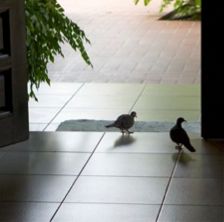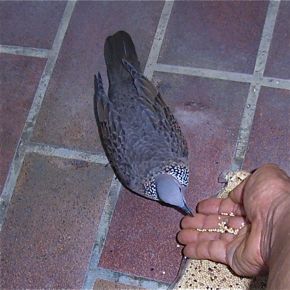I have been feeding the female Spotted Dove (Streptopelia chinensis) in my garden since May 2010. First a single dove visited. In June she brought her partner. By August her partner failed to come. In September, however, her partner returned on and off. Subsequently one or both came to feed on the birdseeds.
At the same time the scattering of birdseeds, then oat flakes, attracted the Eurasian Tree Sparrows (Passer montanus). Both species feed together, the doves swallow the seeds whole while the sparrows ‘dehusk’ them before eating. There are now nine sparrows around most of the time. They are shyer than the doves, flying off whenever I come near. Nowadays the sparrows fly to the ground whenever the doves arrive. The cooing of the doves also brings in the sparrows, which seem to know that food is about to be dispensed.
The doves are getting used to my presence. During my breakfast, one or both will enter the house and approach me, as if asking to be fed (above left). Usually it will leave a drop of poo on the floor if I am late in responding. In the evenings one or the other will wait around the bench where the birdseeds are kept. Once, a dove even entered the house at 6pm when I was having an early dinner.
One of the Spotted Doves is becoming quite tame, allowing me to approach her to within 30 cm. I have even succeeded on a number of occasions to encourage her feed out of my hand. But this takes patience and placing the outstretched hand on the ground (above right).
YC Wee
Singapore
October 2010











4 Responses
Is it OK to feed the Spotted Doves? I was given to understand that we should not feed wild animals? KF
Feeding wild birds has been a common practice in the west… see http://besgroup.talfrynature.com/2010/09/27/how-to-attract-northern-cardinals-using-birdfeeders/#more where birdfeeders are commonly found in home gardens. This has yet to be adopted in this part of the world. A big bonus in my feeding Spotted Doves is that it allows me to watch them in their antics at close range. And so far, I have managed to document new and exciting aspects of behaviour as well as details of morphology.
Well KF, I can assure you that Y C was not the first one feeding wild Spotted Doves,
at least he does not try to capture them and tie them down on a hanging platform
to listen to their cooing, and cooing the whole day long …